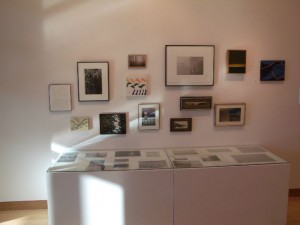Susan Hartung Exhibit Goes On Display

Staff Writer
“Following a Line,” a retrospective of the late artist Susan Hartung’s work, opened at the Teaching Gallery at Hudson Valley on Sep. 25. Hartung passed away only weeks ago, on Sep. 6, at age 74.
The exhibition’s curator, Peter Dudek, gave a talk in the BTC Auditorium, followed by a reception in the Teaching Gallery. Dudek, a man in his sixties with flyaway gray hair and glasses, wearing a black sweater and blue jeans, leaned over the podium and spoke in a measured, low voice about Hartung’s work.
“She didn’t need size to be able to create scale,” he said of Hartung’s pieces, all of which were quite small. He pulled up a slide of “Happy Is As”, a 1974 acrylic on canvas with horizontal bands of various colors against a white background.
“One could easily imagine this painting to be, you know, that big,” said Dudek, referring to the size of the projection, “But it’s just, you know,” holding his hands less than a foot apart, “that big.” “Happy Is As” is a 6-by-10-inch painting.
In his introductory essay to the exhibit catalog, Dudek writes, “It’s a personal thing. Much of what Susan has made is measured in inches, not feet. In her paintings, as in her drawings, size reinforces an intimacy.”
The Teaching Gallery invites viewers to come close; nearly half of the 53 pieces on display are smaller than a piece of letter-sized paper, and the largest piece is 32-by-48 inches. The paintings, drawings, and photographs are hung in simple frames and given adequate wall space to let them breathe.
Rosemary Starace, who edited Hartung’s 2011 poetry collection “Inclusion,” attended the curator talk and recalled that in email correspondence, Hartung described her poetry with words “like ‘precision,’ ‘connecting,’ ‘compression,’ ‘detail,’ ‘observation,’” qualities which can easily be ascribed to her visual art as well.
“Following a Line” is a quiet, introspective exhibit. Many pieces in the exhibit are in muted, nearly monochromatic colors. Dudek has divided it into three parts: the Introductory Space, containing recent work; the Discovery Hall, containing small pieces and ephemera that inspired them; and the Dialog Room, containing work from the 1960s to the 2000s.
The Introductory Space contained three series: Beaufort, Notations, and Rune. The Beaufort series, inspired by the effects of wind on water, are dense fields of wavy horizontal graphite lines on cream-colored paper. The Notations series are sparser, roughly vertical fields of graphite lines over hand-drawn grids. The Rune series are sparely drawn graphite curves over hand-drawn grids, which Dudek writes, “evoke Nordic lettering from the runic alphabets.”
These ‘runes’ seemed far too curvilinear and tentatively rendered to recall the abrupt, sharp lines of Old Norse. My favorite pieces in this space were among the “Unmapped”, which Dudek writes, “don’t fit into those [prior] categories [but are] important to include and singular in their presence.”
The Discovery Hall, with its trove of ephemera, including photographs, drafts, paint swatches, and a couple books of poetry published by Hartung, was, Dudek said in his talk, “really her chance to open up and show what she wanted.” Here, an observant viewer can spot photographs that clearly influenced paintings; a pile of tangled fishing nets finds an echo in the composition of Hartung’s 2004 acrylic “Pulse.”
The Dialog Room, with its 40-year span of work, contains my favorite piece of the exhibit, “Unmapped, Untitled”, a 29-by-22-inch acrylic on canvas from 2004, with a tangle of orange, yellow, and green lines on a deep blue background.
It caught my eye from across the room – more so than pieces with similarly saturated colors, like “Maryland Avenue”, a deep red blaze – and I let myself get lost in the piece until a student gallery employee approached and told me that the gallery was closing. It was 6 p.m.
“Following a Line” runs through Oct. 25. The Teaching Gallery is open Tuesday, Thursday and Friday from 10 a.m. – 4 p.m.; Wednesday from 1-7 p.m.; and Saturday from noon – 4 p.m.
